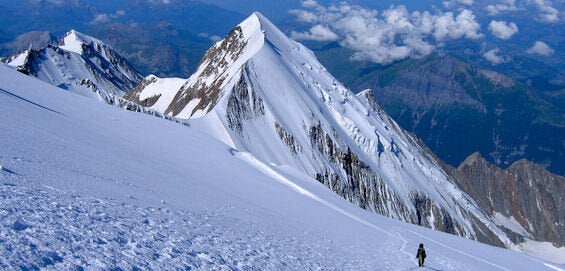Towering enviably above the other peaks in the Alps, Mont Blanc reaches a gargantuan 4,810 metres- making it the highest mountain in Europe. The year round snow and ice draped over the massif also provides an incredible draw to the location as a reputed winter sports playground. Over 20,000 climbers a year mount the summit, whilst others hurry in their droves to snowboard, ski and circumnavigate the peak at lower levels. Now as the saying goes: with great fame comes great responsibility. But Mont Blanc's tripartite territorial ownership between France, Italy and Switzerland confuses matters: with whom does this responsibility lie?

Descent towards the valley from Mont Blanc. Credit Clément Belleudy
Here's the bit I find concerning. Although the prestigious peak is widely revered as an area of outstanding beauty, it is not actually protected with a conservation strategy consistent accross all three parent countries. In France, Mont Blanc was designated a 'site classé' in 1951, preventing development, camping and also supervises amenities. We must ask ourselves, is this enough? It is surprising that for such a popular destination there has been no further international protective status designated, which might elevate its defence to that of a National Park, for example. As we begin to see the truly radical and fast-moving effects of climate change on mountains around the world, it is clear that this matter is pressing. We only have to look at the startling rate at which the glacial ice on Kilimanjaro is disappearing to remind ourselves that, despite their imposing sizes, mountains are also fragile environments.
Climate change is only one issue in a large spectrum of environmental threats which continue to pervade Mont Blanc. There is overcrowding, littering and pollution of the atmosphere just to name a few. In terms of the latter, the atmosphere in both senses of the word is in a vulnerable state. People visit the Alps to take in the vistas, the sporting activities and, as part of the package, the clean, crisp air. However, it is the ambience- the sense of serene tranquility- which makes the experience really special. Either way, a roaring private airplane tour sputtering out toxic fumes is going to ruin both the physical and immaterial environment. These flights are becoming extremely popular as a 'prize' offered to customers at ski resorts to encourage people to book, but they are rather more a punishment to the surroundings and those attempting to enjoy them.
Though the mountain's lack of official, unified strategy for the future is surprising to most, it has not gone unnoticed by all. Mountain Wilderness, a conservation group formed in Biella, Italy, in 1987, pioneers campaigns for the protection of wild mountain areas, defined as: 'any untouched mountain environment where anyone who so wishes may come into direct contact with the wide-open spaces, experience solitude, silence, rhythms, natural dimensions, laws and dangers.' Their most recent project, named 'Silence', is a plea for just that, and is aimed at the chartered tourist aviation which impedes on the sacrosanct calm of the massif. Participants climbed 3,400m up the Col du Geant and created the installation by spelling their single worded demand out with plastic bags in giant letters. 'We cannot pretend there's no solution,' say spokespeople from the group, 'There is an aerial motorized tourism that should be more restricted in the future. This is why we set up this symbolic action.'
Fortunately Mountain Wilderness are not alone in their struggle to absolve the challenges faced by the peak. The 'Espace Mont Blanc' group was formed in 1991 with the main purpose of bringing about a protective status for the area as a UNESCO World Heritage Site. Unfortnately, this issue of organising the future management of Mont Blanc seems mountainous in itself, as nothing can be done without a unified and perfected route of action which can then be controlled by European juducial statute. Until the epic custody battle is settled and whilst there is no international agreement in place, the mountain is far more vulnerable than it might appear. Therefore it is of even greater importance right now for each individual tourist to make sure that they aren't making a detrimental impact on the mountain by travelling responsibly. So, what can the tourist do about it? I'm not suggesting that everybody goes about writing with bags at altitude, but there are a few basic rules to follow which could drastically improve the Mont Blanc experience and the sustainable development of the region.
First off, don't take a tourist flight over the mountain (even if the views are reportedly spectacular), it just isn't worth the double-edged cost to the environment. Next, remember to support the work of Espace Mont Blanc, Mountain Wilderderness and all the other NGOs under the 'Pro Mont Blanc' umbrella by learning a little more about their aims before you travel. Finally, and perhaps most importantly, make sure to travel with a reponsible tour operator: there are plenty of trips out there designed to have your best interests at heart, without compromising the security of Mont Blanc's future.
For more information on how to travel responsibly to Mont Blanc, visit www.responsibletravel.com/holidays/mont-blanc/travel-guide.